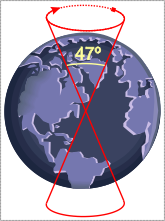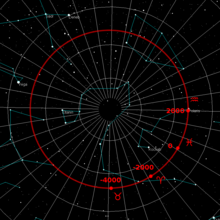大年

大年这个名词有有两个主要含义。在科学的天文学将其定义为分点在黄道上完成一个完整的分点绕行周期,即25,800年;现时接受的更精确数值是25,772年[1]。地轴在北方夜空中的位置,现时几乎与邻近北极点的北极星勾陈一对齐。这只是一个偶然的巧合,过去并不是如此,在一个大年中也不会再有这样的现象。
柏拉图年[2]也称为大年,它有着不同的更古老、更神秘的含义。柏拉图假设太阳、月球和肉眼可见行星在轨道上运动会随着时间向前或向后弯曲,就会到达与现在相同的点,也就是在天球上回到相同的位置。他称这个时间周期为大年,并建议这统一回归美发生一次的长度大约为36,000年。但没有证据显示这种重新调整的事件曾经发生过,事实上也永远不会发生[3][4]。
推而广之,大年这个词可以用来指世界上的神话或哲学中的任何类型永恒轮回的概念。历史学家奥托·纽格伯尔(Otto Neugebauer)写道:
大年的困难在于它的模糊性。几乎在任何时期都可以在某个时间或某个地方找到这个名词[5]。
科学描述

黄道面是太阳在星空背景下的视运动所描绘的平面。它实际上是地球绕太阳的轨道运动引起的视运动。地球的自转轴不是垂直于这个平面,而是与垂直面成约23.5度角。因为在地球绕太阳公转的一年中,轴线在空间中的指向保持不变,因此北极和南极正上方的点保持不变[6]。
由于地球赤道的隆起,受到其它天体引力的影响,地球自转轴有着绕其垂直于黄道面轴的缓慢圆锥运动;在受到侧向力的陀螺仪中也可以观察到类似的锥形运动。
地轴指向的合成运动被称为一般进动,因此黄道上的春分点以每年大约50.3弧秒的速率沿着黄道向西移动。经历25,772年,这个点再次回到在天空中开始观测的同一点上[2]。
此外,地球自转轴的倾斜或转轴倾角不是固定的,而是在自身的周期中变化著。在平均约40,000年的周期中,转轴的倾角会在22.1度到24.5度之间变化[7]。

两种定义的历史
柏拉图(约公元前360年)用完美年(perfect year)一词来描述天体([行星])) 的周日运动回归至固定于恒星的原来位置(同一个圆),没有证据表明他对岁差有任何了解[8]。柏拉图所描述的周期是行星和星体会合的周期,这可以在没有任何岁差概念的情况下假设。
大约在柏拉图死后200年,喜帕恰斯(Hipparchus,大约公元前120年)是第一位发现岁差的希腊人(见下文)。
西塞罗(Cicero,公元前1世纪)跟随柏拉图将大年定义为太阳、月球和行星周期的组合[9][10]。
柏拉图对完美年的描述可以在他的对话录中找到。
因此,人们几乎不知道这样一个事实:时间真的是这些躯体的游荡,它们数量之多令人困惑,种类之多令人惊讶。尽管如此,当相对的八个周期一起完成,并且以速度均匀相同的圆来测量,已然达到了它们的完美时,我们就能以完美的时间数带来完美年[11]。
在《自然》杂志上,西塞罗写道:
根据行星不同的运动,太阳、月球和五颗行星都完成了它们的运动,回到彼此相对的相同位置时的时间,数学家称之为大年。这段时间的长短引起了激烈的争论,但它须是一个固定和确定的时间[9]。
马克罗比乌斯(Macrobius,西元五世纪早期)在他西塞罗的Somnium Scipionis评论中指出:哲学家们认为大年是15,000年[12]。
肯索里努斯(Censorinus,公元3世纪)写道阿里斯塔克斯(Aristarchus of Samos)认为一个大年是2484年,但有人认为这是对2434年的错误复制,它代表了45个轮转周期[12][13]。
柏拉图年的起源似乎与分点的进动无关,因为在柏拉图时代对这仍是一无所知[14]。分点岁差的周期,被认为是在柏拉图之后的两个世纪,才被喜帕恰斯发现[15],大年这个词汇,最终被用来指由地轴缓慢旋转引起的岁差周期。
大约在公元前二世纪中叶,喜帕恰斯发现,以固定的恒星作为一个整体,在每年确定分点和至点位置时,它们的位置会逐渐改变…奥托·纽格伯尔认为,喜帕恰斯实际上认为36,000年是最大的数值,他还计算了一个完整岁差周期的真实数值,刚好低于26,000年…[16]。
有人认为,两者之间的混淆源于天文学家托勒密(约公元170年),他采用了更大的错误数值。其结果是从此之后,两个版本的大年━由行星定义的柏拉图大年,和由恒星定义的岁差大年━将越来越混淆[17]。
托勒密甚至被指控犯下科学诈欺罪,编造观测的数据以得出36,000年的数值,而不顾他掌握的数据足够好,非常接近26,000年的真实数值[18]。
约瑟夫斯(Josephus古希腊语:μέγας ἐνιαυτός,公元37-100年)指的大年是600年[19]。
上帝赋予他们更长的生命,是因为它们的美德,以及他们在天文学和几何学的发现中充分利用了这些美德,除非他们活了600年,否则就没有足够的时间来预言[恒星的周期];因为大年就是在这段时间内完成的[19]。
有人认为,他是从贝罗梭斯(约公元前3世纪)获得这个值,以60年、600年和3,600年为间隔计算时间[20]。
艾萨克·牛顿 (1643 –1726) 确定了岁差的原因,并确定了岁差值为每72年1度,非常接近现在测得的最佳值,从而证明了早期每世纪1度的误差大小[21]。
相关条目
参考资料
- ^ Precession of the Earth's Axis - Wolfram Demonstrations Project. demonstrations.wolfram.com. [2019-02-10]. (原始内容存档于2019-04-28) (英语).
- ^ 2.0 2.1 Aerospace Science and Technology Dictionary G Section. Hq.nasa.gov. 1989-10-18 [2014-03-02]. (原始内容存档于2015-01-15).
- ^ Walter Cruttenden, "Lost Star of Myth and Time" (St. Lynn's Press, 2006), p.xix–xx.
- ^ Why was the Platonic year named after Plato? (Intermediate) - Curious About Astronomy? Ask an Astronomer. curious.astro.cornell.edu. [2019-02-19]. (原始内容存档于2019-01-22).
- ^ Neugebauer O., (1975) A History of Ancient mathematical astronomy, Birkhäuser, p.618
- ^ Aerospace Science and Technonlogy Dictionary P Section. www.hq.nasa.gov. [2019-02-09]. (原始内容存档于2016-03-31).
- ^ Milutin Milankovitch. earthobservatory.nasa.gov. 2000-03-24 [2019-02-15]. (原始内容存档于2020-01-16) (英语).
- ^ Wood, Michael. The Platonic Year. Oxford University Press. 2010-06-24 [2021-03-29]. ISBN 9780191701726. doi:10.1093/acprof:oso/9780199557660.001.0001/acprof-9780199557660-chapter-3. (原始内容存档于2019-03-29) (美国英语).
- ^ 9.0 9.1 Cicero, De Natura Deorum II.51. Full text with an English translation by H. Rackham". Loeb Classical Library, Heinemann/Archive.org. 1933 [2019-11-13].
- ^ Nicholas Campion, "The Great Year: Astrology, Millenarianism and History in the Western Tradition" (Arkana/Penguin Books, 1994), p. 6.
- ^ Plato, Timaeus 39d, in John M. Cooper (ed.), "Plato: Complete Works" (Hackett Publishing Company, 1997), p. 1243
- ^ 12.0 12.1 J. D. North. Stars, Mind & Fate: Essays in Ancient and Mediaeval Cosmology. Bloomsbury Academic. 1989: 96. ISBN 978-0-907628-94-1.
- ^ Aristarchos & System B 2002 , DIO 11.1 May 31 (p. 6) Comments on the Aristarchan Evidence http://www.dioi.org/vols/wb1.pdf (页面存档备份,存于互联网档案馆)
- ^ William Harris Stahl, "Macrobius: Commentary on the Dream of Scipio" (Columbia University Press, 1952), p. 21
- ^ Aerospace Science and Technonlogy Dictionary G Section. Hq.nasa.gov. 1989-10-18 [2015-08-23]. (原始内容存档于2015-09-17).
- ^ Nicholas Campion, "The Great Year: Astrology, Millenarianism and History in the Western Tradition" (Arkana/Penguin Books, 1994), p.246.
- ^ Nicholas Campion, "The Great Year: Astrology, Millenarianism and History in the Western Tradition" (Arkana/Penguin Books, 1994), p. 246–247.
- ^ R.R.Newton, "The Authenticity of Ptolemy's star data"
- ^ 19.0 19.1 Josephus – Antiquities of the Jews – Book I, Chapter 3, Paragraph 9. [2021-03-29]. (原始内容存档于2017-12-31).
- ^ Josephus, Jewish Antiquities, Loeb, p.1, note a,
- ^ Internet History Sourcebooks. Fordham.edu: letter 17. [2014-03-02]. (原始内容存档于2014-09-08).
进阶读物
- Callatay G. de, Annus Platonicus, A Study of World Cycles in Greek Latin and Arabian Sources, Publication de l'Institut Orientaliste de Louvain #47, Louvain, 1996
- Nicholas Campion, "The Great Year" (ISBN 0140192964), Penguin, 1994
- Walter Cruttenden, "The Great Year" (documentary film), The Yuga Project, DVD 2003
- Boris Cristoff, "El destino de la humanidad" (Barcelona, editorial Martínez Roca, 1981; colección Fontana
- Thomas C. Mcevilley, “The Shape of Ancient Thought: Comparative Studies in Greek and Indian Philosophy” (chapter 3, The Cosmic Cycle) (ISBN 1581152035), Allworth, 2001
Text is available under the CC BY-SA 4.0 license; additional terms may apply.
Images, videos and audio are available under their respective licenses.
